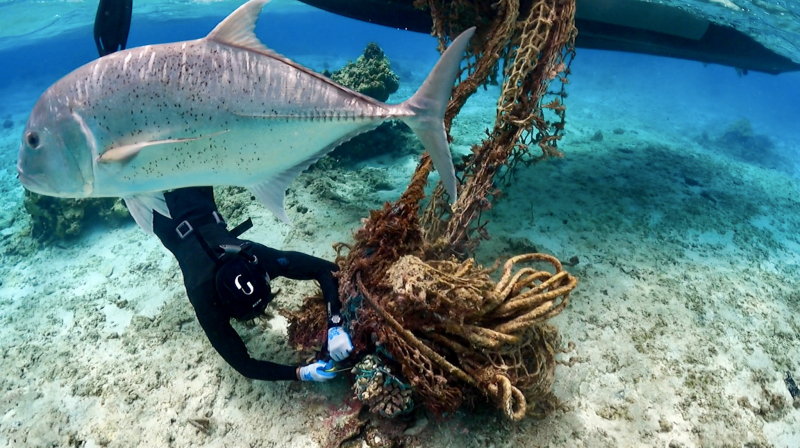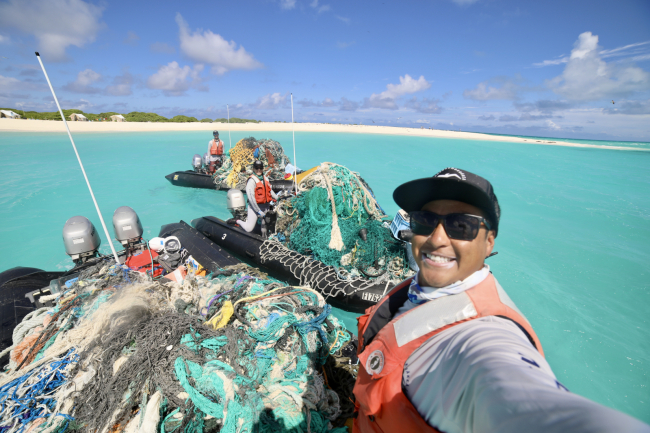On Wednesday, September 22, the NOAA Pacific Islands Fisheries Science Center’s Marine Debris Project team, joined by the non-profit Papahānaumokuākea Marine Debris Project, marked the completion of their marine debris removal mission in the Papahānaumokuākea Marine National Monument (monument). The team arrived at Pearl Harbor aboard the charter vessel IMUA along with the nearly 124,000 pounds of marine debris removed during the 30-day mission.
Marine debris removal is of critical importance to both the natural and cultural components of the monument. Papahānaumokuākea is a sacred Native Hawaiian landscape. The monument was also designated as a mixed natural and cultural World Heritage Site by the United Nations Educational, Scientific and Cultural Organization, and is one of the largest fully protected marine conservation areas on the planet, spanning 582,578 square miles. Biocultural conservation and restoration, natural resource management and stewardship centered around human connection to place and natural and cultural resources, honors and perpetuates the spiritual and cultural relationships with Papahānaumokuākea by affirming respect and reciprocity. The stewardship effort to address marine debris in the monument is an act of mālama, or care taking and preserving, and enhances the mana, or divine power, of Papahānaumokuākea.

This marine debris removal mission, proudly supported by the NOAA Marine Debris Program, focused on the removal of derelict fishing gear and plastic debris from the shallow coral reef and shoreline environments of the monument. Removal took place at Kure Atoll (Hōlanikū, Mokupāpapa), Midway Atoll (Kuaihelani, Pihemanu), Pearl and Hermes Atoll (Manawai, Holoikauaua), Lisianski Island (Kapou, Papa‘āpoho), Laysan Island (Kamole, Kauō), and Maro Reef (Kamokuokamohoali‘i, and Ko‘anako‘a, Nalukākala).* The marine debris removal team had a goal of removing 115,000 pounds of derelict fishing nets, plastics, and other marine debris. However, over 18 operational days, the team removed 118,400 pounds of derelict fishing nets and nearly 5,300 pounds of plastic and other debris.
- Kamokuokamohoaliʻi —nearly 43,000 pounds
- Kuaihelani —approximately 24,500 pounds
- Manawai —23,650 pounds
- Hōlanikū —nearly 16,000 pounds
- Kapou —nearly 11,500 pounds
- Kamole —more than 5,000 pounds
A total of 295 large nets were removed during the mission. Kamokuokamohoali‘i contained the greatest number of large nets, 195 weighing 42,960 pounds, throughout the mission. More than 16,000 pounds of large nets were found along the shoreline of Kuaihelani and the island of Kapou contained 11,000 pounds of nets. The largest amount of plastics were found on Manawai where the marine debris team removed 3,670 pounds. Hōlanikū was also substantially inundated with 1,270 pounds of plastics and other debris.
This huge undertaking was made possible through the collaboration and partnership of many. The mission was led by the NOAA Pacific Islands Fisheries Science Center and funded by the NOAA Marine Debris Program and NOAA Damage Assessment Remediation and Restoration Program. Additional support for this project comes from Papahānaumokuākea Marine Debris Project, U.S. Fish and Wildlife Service, State of Hawai‘i, NOAA Office of National Marine Sanctuaries, and other NOAA programs. Through the practice of mālama and stewardship it is our hope to perpetuate the mana of Papahānaumokuākea and keep this special landscape free of debris.
*It is important to use the ancient, contemporary, and common names of the islands to acknowledge the historical and cultural significance of Papahānaumokuākea Marine National Monument. Learn more about the ancient and contemporary Hawaiian names here.





Thank you so much for your efforts, we often forget the degradation due to trash that is happening to our underwater ecosystems when all that is visible above the water is beautiful. Your work is inspiring!